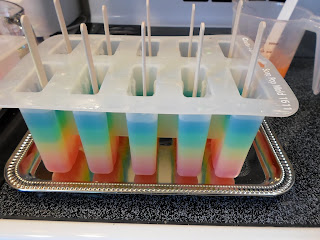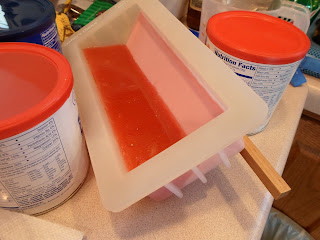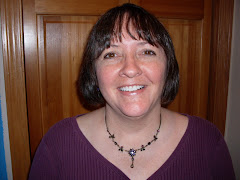I have wrestled with myself on exactly how much of this story to divulge.
I decided to go ahead and tell you the whole thing.
So, here we go.
This is my extra bubbly good for shaving soap.
It has bentonite clay for slip.
It has castor oil for extra lather.
This soap doesn't stay in stock for long.
There is also always a bar or two in my shower.
So I made a 10 pound batch recently.
I added the clay to the liquid oils.
I hadn't done it this way before.
It seemed to work well.

When the soap was at light trace
I added some colorant.
I used Blue Mix Labcolor from Bramble Berry.
It's been my go-to color for this soap.
I usually make three layers
In three variegated (ombre?) shades of blue.
I added Cold Water Fragrance,
Also from Bramble Berry
It's manly, but most women like it too.
Fast forward to the poured soap.
I guess I forgot to take pictures of several steps.
There was so much soap that it filled four loaf molds
Plus a few single bar cavities.
As I was putting supplies away,
I noticed the jug of castor oil.
Yes, jug.
I buy it by the gallon.
Anyway, I realized that I forgot to add the castor oil.
As the oils and lye combine to make soap,
The process of saponification occurs.
That means the oils and lye react
To produce soap.
The process of saponification occurs.
That means the oils and lye react
To produce soap.

Saponification takes the mixture from this
To this.
It also continues for several hours after the soap is poured.
When I design a soap recipe,
I use this SoapMaker program.
It lets me make sure there will be some leftover oils.
I think of it as the oils eating up the lye.
I shoot for about 5-8% more oils
Than what is required to "eat up" the lye.
If you are a soapmaker, it's okay if you chuckle at my
Technical explanation of saponification.
Based on the oils I did remember to use,
And based on the amount of lye used,
The soap was going to come out lye-heavy.
Not by a lot, but by a little.
You could even call it a smidge.
You could even call it a smidge.
But even if I didn't,
I would not be satisfied with lye heavy soap.
Even slightly, barely detectable lye heavy soap.
A really great thing about making soap
Is that you can almost always save a botched batch.
The way I saved this one was by hand milling it.
Here's how I did it.
Two days after the initial pour,
I unmolded the soap.
I cut the slighly lye heavy soap into small chunks.
I put these chunks into a crock pot.
I added the castor oil that I forgot the first time around.
The crockpot was set on low.
I melted the soap down.
It took a few hours.
This is known as rebatching, or milling.
Here's the melted soap glopped into a mold.
After another couple of days,
I unmolded the hand milled soap.
Here it is!
I'm quite happy with the end product.
I've already used part of a bar, and am loving it.
One advantage of hand milling is that
The soap can be used right away.
Usually there is a 3-4 (or more) week waiting period.
Another advantage is that the soap has an interesting look and texture.
I also think it produces more bubbles.
Each bar is one of a kind.
I set a lot of these bars back for personal use,
But a few will go up for sale.
Thanks for reading my hand milled soap saga!
A really great thing about making soap
Is that you can almost always save a botched batch.
The way I saved this one was by hand milling it.
Here's how I did it.
Two days after the initial pour,
I unmolded the soap.
I cut the slighly lye heavy soap into small chunks.
I put these chunks into a crock pot.
I added the castor oil that I forgot the first time around.
The crockpot was set on low.
I melted the soap down.
It took a few hours.
This is known as rebatching, or milling.
Here's the melted soap glopped into a mold.
After another couple of days,
I unmolded the hand milled soap.
Here it is!
I've already used part of a bar, and am loving it.
One advantage of hand milling is that
The soap can be used right away.
Usually there is a 3-4 (or more) week waiting period.
Another advantage is that the soap has an interesting look and texture.
I also think it produces more bubbles.
Each bar is one of a kind.
I set a lot of these bars back for personal use,
But a few will go up for sale.
Thanks for reading my hand milled soap saga!












































































